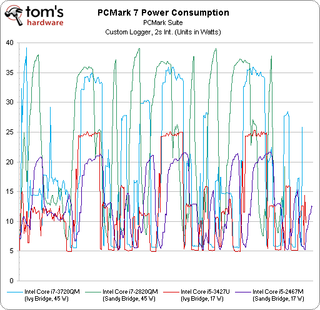Second-Generation Ultrabooks: Faster And Cheaper With Ivy Bridge
Benchmark Results: PCMark 7
Before we dive into the benchmark results, note that we're including Intel's older Arrandale design and AMD's Llano-based APU for reference. Our focus is on the new 17 W Core i5-3427U CPU, though. Specifically, we're interested in measuring the CPU's performance at its lower TDP. For a thorough analysis of how the standard-voltage mobile Ivy Bridge-based processors compare to prior architectures, read Core i7-3720QM: Ivy Bridge Makes Its Mark On Mobility.

Sporting a base clock of 1.8 GHz that accelerates up to 3.6 GHz via Turbo Boost, the Ivy Bridge-based Core i5-3427U outpaces the Sandy Bridge-based -2467M by ~66%.
At least on paper, the new 17 W part even outmaneuvers a 45 W Core i7-2820QM with four cores, a much larger shared L3 cache, and a higher base frequency. Seem implausible? Let's drill down into PCMark's scoring methodology.
| PCMark 7 Results | i7-3720QM | i7-2820QM | i5-3427U | i5-2467M |
|---|---|---|---|---|
| Video Playback | 23.12 FPS | 23.16 FPS | 23.16 FPS | 23.19 FPS |
| Video Transcoding | 169 531.73 KB/s | 17 416.99 KB/s | 179 126.24 KB/s | 9366.03 KB/s |
| Storage: Gaming | 15.22 MB/s | 14.87 MB/s | 15.17 MB/s | 15.37 MB/s |
| Graphics DX 9 | 22.99 FPS | 17.47 FPS | 17.54 FPS | 10.45 FPS |
| Image Manipulation | 11.55 Mpix/s | 9.3 Mpix/s | 8.80 Mpix/s | 6.48 Mpix/s |
| Storage: Importing Pictures | 26.37 MB/s | 26.58 MB/s | 26.05 MB/s | 24.72 MB/s |
| Web Browsing | 15.17 pages/s | 14.24 pages/s | 10.14 pages/s | 7.79 pages/s |
| Data Decrypting | 145.54 MB/s | 101.31 MB/s | 90.91 MB/s | 54.54 MB/s |
| Storage: Windows Defender | 5.37 MB/s | 5.25 MB/s | 5.39 MB/s | 5.41 MB/s |
The Ivy Bridge architecture's advantage is wholly attributable to PCMark's weighting system. For one reason or another, Futuremark is giving Intel's new Quick Sync implementation an almost-order-of-magnitude lead over what the company achieved last generation in its Video Transcoding test. Because PCMark weighs this particular discipline so heavily, the overall result favors the new 17 W chip. In other, more CPU-intensive tests, the 45 W Core i7 is actually faster.
When it comes to gaming, the new Ivy Bridge-based parts excel in PCMark's DirectX 9 component. Intel's extra investment in graphics performance seems to really pay off.

The dual-core Core i5-3427U and i5-2467M processors have to work much harder in PCMark 7 than the quad-core models, suggested by much higher spikes in CPU utilization. Comparing those peaks, we see that the Ivy Bridge-based Ultrabook seems to move through its workload slightly faster, though in other places, the usage numbers aren't as telling.
When it's working hard, the Ivy Bridge-based platform uses more power than Sandy Bridge, but the reverse is true when utilization is lower. At the end of the day, both platforms end up chewing up the same amount of energy. An updated architecture simply allows Ivy Bridge to serve up better performance in the process.
Stay on the Cutting Edge
Join the experts who read Tom's Hardware for the inside track on enthusiast PC tech news — and have for over 25 years. We'll send breaking news and in-depth reviews of CPUs, GPUs, AI, maker hardware and more straight to your inbox.

Current page: Benchmark Results: PCMark 7
Prev Page Ivy Bridge Shows Up At 17 W In Intel's Second-Gen Ultrabook Next Page Benchmark Results: Adobe Photoshop CS 5-
sam_fisher It seems that Ivy Bridge's lower TDP and its HD 4000 comes into its own in the notebook/ultrabook market more so than the PC/gaming one.Reply -
sam_fisher crisan_tiberiuthey should use HD 4000 on every intel CPU, i dont get it why they dont ...Reply
The integrated graphics is built into the processor die and the changes between the HD 3000 and 4000 are physical changes, so they can't just change them without changing the whole CPU.
-
mayankleoboy1 crisan_tiberiuthey should use HD 4000 on every intel CPU, i dont get it why they dont ...Reply
Pricing, TDP, segmentation and PROFIT -
crisan_tiberiu sam_fisherThe integrated graphics is built into the processor die and the changes between the HD 3000 and 4000 are physical changes, so they can't just change them without changing the whole CPU. Yes, i know that :)) but when they designed IVY they should have designed every chip with the HD 4000. The HD 4000 is still outperformed by Liano iGPU if you remember...Reply -
tomfreak Cant u put an older/previous generation desktop and benchmark against it? I cant or couldnt get how a fast a 2.0GHz Ivy vs a similar Nehelem Desktop CPU vs desktop core 2 duo CPU. Many of us buy notebook to replace desktop for casual use, we would like to know what it can do vs our old desktop.Reply
Besides get some older AAA games to bench, nobody play BF3 at Ultra books with HD4000. We wanna see what old games we can max out @ full resolution. -
silverblue I think AMD missed a trick with Llano. Instead of throwing four lowly clocked cores at a mobile processor, perhaps two higher clocked cores would've made much more sense. That way, they could possibly sport a higher clock GPU as well within the same TDP.Reply
Trinity's lower powered, higher clocked cores already look to have partly made up for this, but until the 17W variant comes along, there's no real indication of how it'll measure up to IB ULV. However, we do know that AMD pairs the slower GPUs with the slower CPUs and vice versa, so there's little chance of a, say, 2C/2T/1M CPU with the 7660G GPU. -
DjEaZy ... ok... you compare the Llano to Sandy/Ivy bridge in CPU performance, but not in GPU performance? and why not Sandy/Ivy Bridge to Trinity?Reply
... and Adobe Photoshop CS 5? not CS 6?
Most Popular

